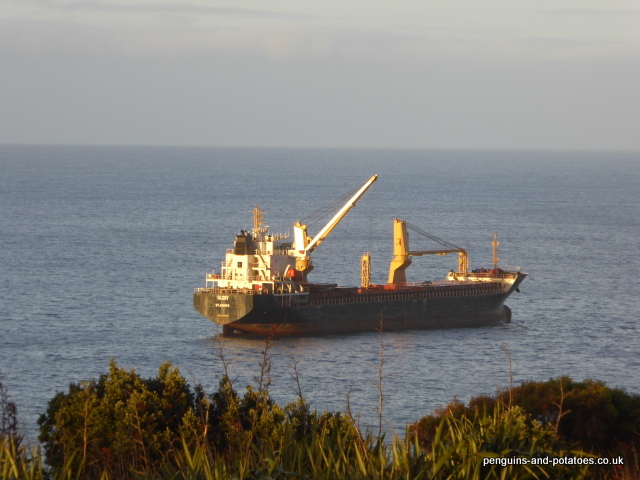
Month: January 2017
First Two Months on Tristan
It has been an extraordinarily busy time of the year.
For us, having arrived on November 30th, we went first into temporary accommodation as guests of Pat and Peter. This was a good experience, they are lovely people and we heard many tales of the old days on Tristan, including the time of the evacuation. After two weeks we moved into our ‘permanent’ place, which in one of the old original Scots-built houses from the very early 1800’s. It has some good points and some not-so-good. The kitchen is great, a good size and with reasonable work-tops, but – no hot water yet! The view from the house is really superb. Then – it is debatable as to whether our proximity to the pub is good or not!
The whole island closes down for three weeks over Christmas, all except some essential services. This is the annual summer holiday. Many of the islanders go down ‘camping’ at the Patches, where they have simple huts beside their potato plots. The holiday period was this time interrupted by two Unloading Days, on Christmas Eve and Boxing Day. Certainly not ideal, but it had to be done.
As befits an island community that was founded by a Scot, Auld Year’s Night or Hogmanay is taken quite seriously. All were invited to a party on the lawn of the Residence, where the Administrator lives. This was our first experience of an island-wide social event. During the late afternoon before the event we noticed a number of monsters on the streets – there were all together about twelve very frightening monsters; seemingly they go around making reasonably harmless mischief, and then they come in to the garden party at the Residence. These are called Okalolies, and the tradition for them on the island goes back a very long time. I will try to find out more, and report back! Parties go on into the wee small hours, with New Year announced at midnight by much ringing of the gong.
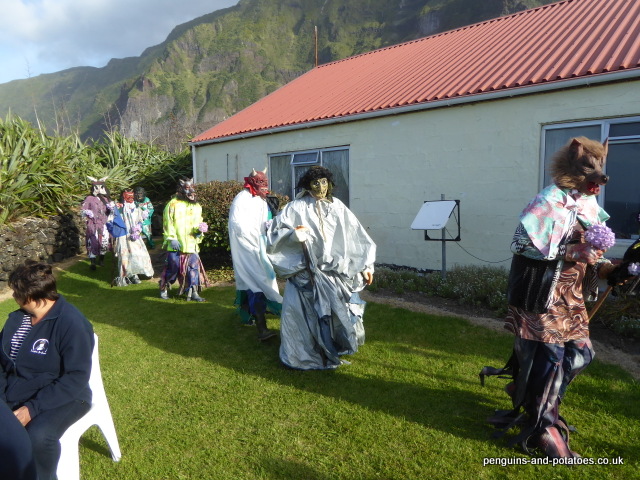
The holiday did not apply to the ex-pats, and in any case holiday or not I was quite occupied preparing my Inception Report. This is a comprehensive and detailed piece of work outlining the agricultural situation on the island today, with in mind discussion and decision making which in turn will provide me with a programme to work to in the two years to come. This is now all done, and I was able to present it to the Island Council on the 18th January. We are due to have a sort of brainstorming meeting as a follow-up in about ten days’ time.
On the 13th and 14th of January, we had Shearing Day. This is the annual community event when almost everyone goes down to the sheep pens, and in good island tradition work and fun are joined together. The entire flock of around 1,000 sheep is collected in the central area of the sheep pens, and each owner draws out his own sheep, which he keeps in his own pen ready for shearing. This is a time when sheep owners help each other, and when children get involved with the nitty gritty of sheep farming. Bystanders and their cars and motorbikes surround the sheep pens area, music is played – and many of the women can be seen knitting. Once the work is all done, it is time to celebrate, and bries (barbecues) and partying go on late into the evening.
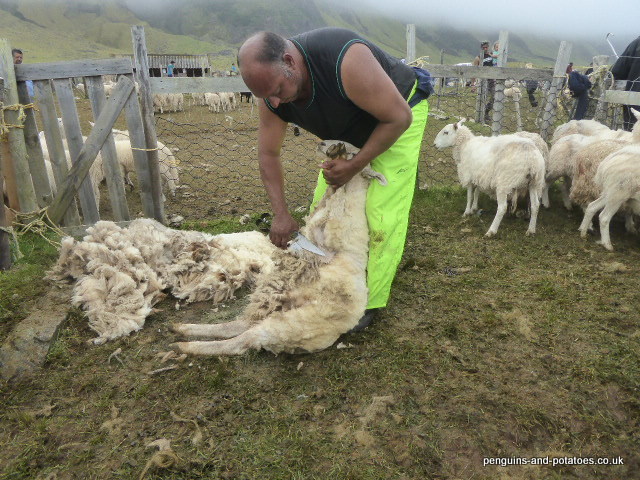
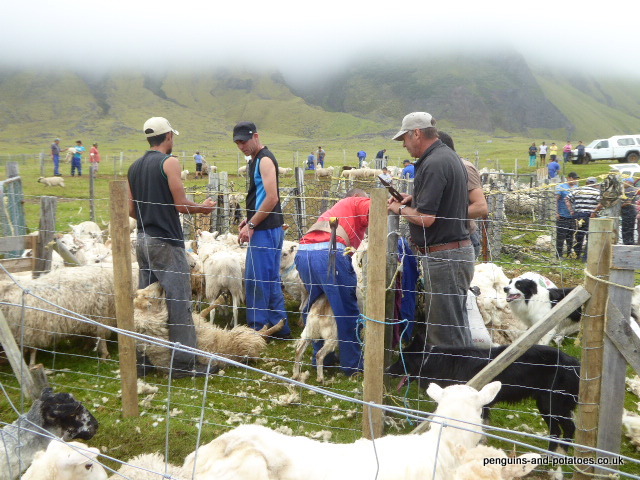
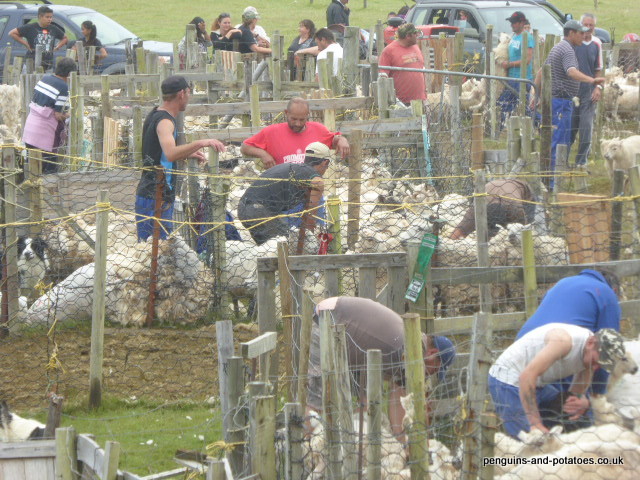

We have had visits from four ships in the last week. Late on the 14th, HMS Portland arrived together with her merchant navy escort ship. Crew from the ships became tourists, and in spite of it being Sunday the supermarket stayed open, the tourist shop and gift shop opened, and the pub opened. The Navy played the Island at football, and the last of the Navy visitors were taken back to their ship around 7.00 in the evening. There were many empty cans left behind! Meanwhile, a ship chartered by the National Geographic arrived. Grenville is on a research and filming expedition to Tristan and the nearby islands of Nightingale and Inaccessible as well as Gough Island, some 200 miles further south. She was also carrying a number of passengers who were either people coming to work here or Islanders returning home.
The fourth ship was the Pacific Askari, with another consignment of building materials for the new hospital. She was unloaded quickly and left the following day.
We (particularly of course Bee) are now involved in preparations for a Wedding, due to take place on the 20th. Mike and Nena have been here for around 18 months, and because he is in charge (among other things) of all the unloading operations, which are so weather-dependent and so crucial, they have had to postpone their wedding twice because it clashed with a window in the weather that allowed unloading to resume.
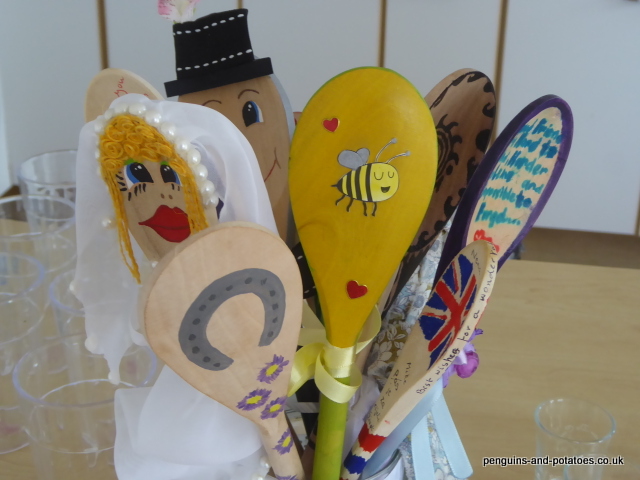
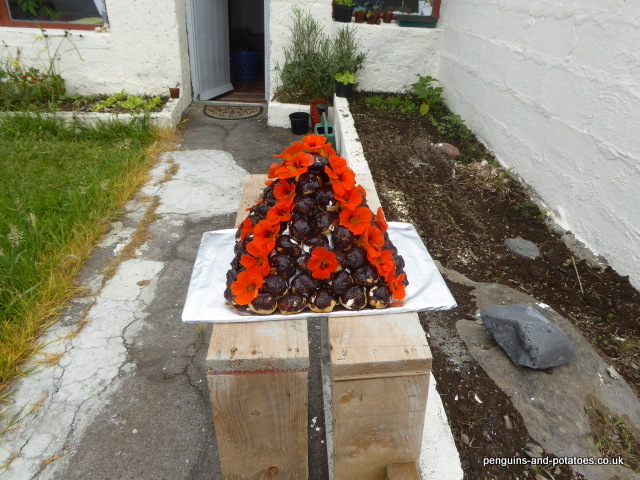
- Profiterole Pyramid, ready for the wedding
TdC Shipping
We have seen at first hand how difficult things can be on Tristan da Cunha.
I am referring to shipping, and the flow of essential goods arriving and leaving the island.
Like all islands, Tristan is entirely dependent on shipping. Most inhabited islands have the benefit of a sheltered bay, a natural harbour, or otherwise some shelter for its man-made harbour. Here, a new small-boat harbour was built on an exposed storm-prone coastline in or around 1965.
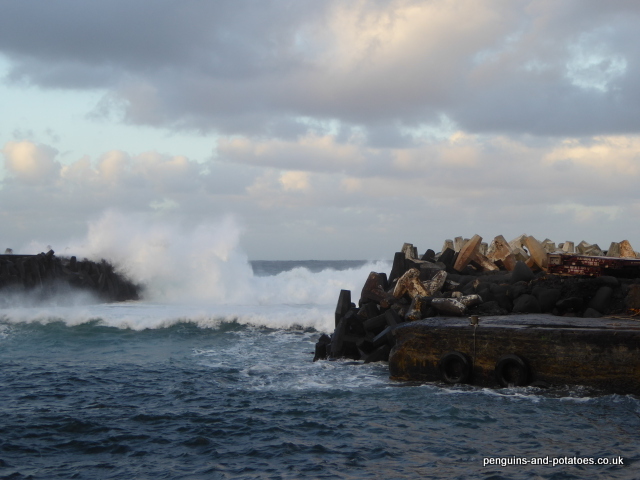
The unloading process into this tiny harbour is intrinsically difficult. Ships anchor off, about ½ mile outside the harbour, and one, two or occasionally three motorised rafts ferry the cargo from ship to harbour. Each raft needs a crew of four, and takes up to 20 tonnes of freight. Once the raft is inside the harbour and tied up, the freight is unloaded by a large crane, generally onto an awaiting tractor and trailer which shuttles the item up to where it is needed.
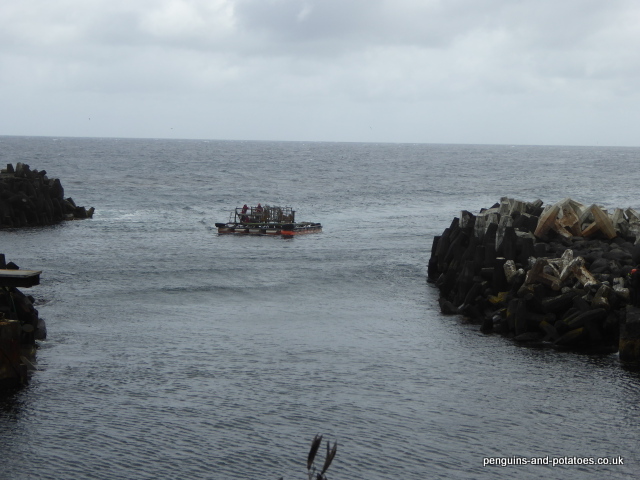
The main revenue-earning product that leaves the island is crayfish, known in some markets as Tristan Island Lobster. This provides the main revenue stream for the island, and paid employment for a large proportion of the islanders. But – and it is a big ‘but’ – this economic and monetary life-line is only as good as the harbour and the shipping links to the outside world via our nearest port of Cape Town (some 1,600 miles to the east)
In the same way, everything coming onto the island does so via this link of long shipping journeys and a harbour that is accessible only in very good weather. Machinery, building materials and other capital resources come in via this route. But also it is the only route for essential items like fruit, vegetables, flour, sugar, gas for cooking, diesel for the cars, and so on.
So – I have outlined how important the harbour is for the survival of the community here. Now let me describe the reality of how difficult it can be. We arrived on the Baltic Trader. When we arrived there were two other ships involved. The Edinburgh was elsewhere in the islands, fishing for crayfish when weather permitted and due to come back to upload stocks of crayfish from the factory here to take to Cape Town, and the Glory which was sheltering in the lee of the island. The Glory carried a ‘kit’ of construction materials for the new hospital that is being built here. She arrived here on 4th November, and started unloading before the harbour was closed due to bad weather and heavy swells. A 12-man construction team were on the island, and they only had components for the hospital to last until about December 27, after which they would be twiddling their thumbs.
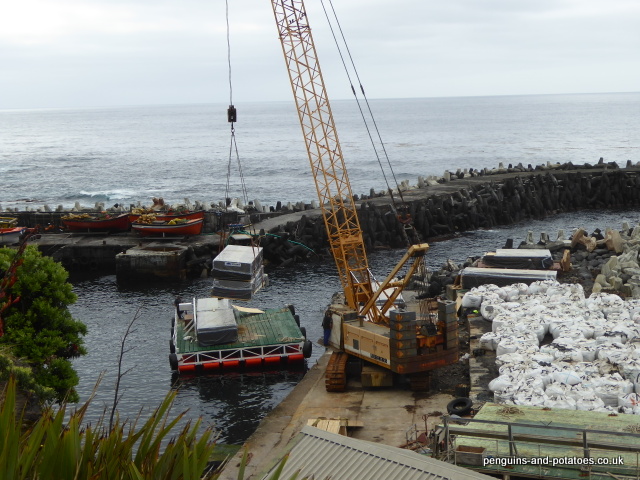
We arrived on the Baltic Trader on November 30th. After we were unloaded into the harbour, with just the hand luggage that we had in the tiny cabin on the boat, the harbour was again closed and it was seven days before conditions allowed it to open again, to resume unloading. That is when we received our suitcases, and the shop received tons and tons of food items. This little window in the weather was insufficient to finish the job, and the harbour was once again closed.
‘Unloading Day’ is a big day here. It is an ‘all hands’ day, in which all Government departments pool their resources, and all staff concentrate on the task of unloading. When there is a ship to unload, an assessment is made very early in the morning to ascertain whether unloading will be possible, looking at actual weather, up-to-date weather forecast, height and direction of swell, and so on. If an unloading day is deemed to be possible, the community is notified by the ringing of the gong at 5.30 in the morning. The gong is a suspended gas bottle, sited centrally just at the back of the pub, and twelve strikes on the gong lets everyone know what their priority is for the day – an unloading day has been declared!
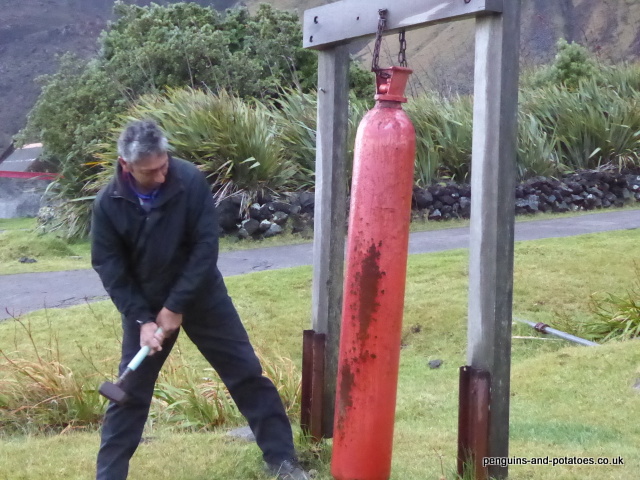
The next time that there was an unloading day, on 12th December, it was the Edinburgh that was given priority. The team were able to complete the backloading of the crawfish in the day, and the ship was able to set course for Cape Town – one less vessel in the queue!
It was not until December 22nd that the gong was again heard, and the Baltic Trader opened her hatches for unloading to continue. Two hundred tonnes of building stone for the harbour were unloaded, then there was backloading of empty 3 tonne petrol tanks, empty gas bottles, one sole passenger and 35 tonnes of frozen crawfish went on board, and the Baltic Trader left for Cape Town before weather conditions once again closed in.
Two down, one to go! On the 24th work started once again on the Glory, Christmas Day was foul and no unloading took place, but finally on Boxing Day the remaining materials for the hospital were unloaded and as darkness approached the ship was able to set course for Cape Town.
The Glory was in total 51 days at Tristan da Cunha, for a total of 11 days unloading. She was here for so long she even transferred 4 tonnes of fuel from the Baltic Trader – the only alternative of which would have been to go all the way to Cape Town simply for fuel, which in itself would have taken the best part of three weeks.
These are just some of the logistical problems of getting things done on the Remotest Inhabited Island in the World.
